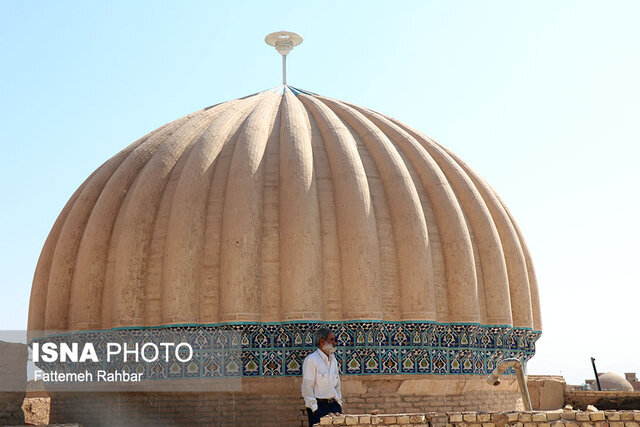
TEHRAN- A restoration project has recently been commenced on the dome of the tomb of Setti Fatemeh Khatun in the central province of Yazd, a local tourism official has said.
The Teymurid-era (1370–1507) structure, which has the only fluted dome in the country, is the tomb of Setti Fatemeh, the wife of Jalal ed-Din Amir Chakhmaq Shami, the governor of Yazd and a general of Shahrukh the Emperor of the Timurid Empire. She was also the sister of Goharshad, Shahrukh’s wife.
The plaster on the decorations and Quranic inscriptions inside the dome are being removed, ISNA quoted Majid Oloumi as saying on Saturday.
Although all the inscriptions couldn’t be restored, the restorers try their best to preserve the originality of them, considering their artistic and architectural values, the official added.
Setti Fatemeh played a key role in the development of the city of Yazd along with her husband. She was known for her charity welfare works such as constructing mosques, cisterns, caravanserais, gardens and bazaars.
The tomb is located opposite of Amir Chakhmaq Complex on a square of the same name, a prominent complex, which is noted for its eye-catching rows of symmetrical sunken alcoves that are perfectly lit up following the sunset.
In July 2017, the historical structure of the city of Yazd was named a UNESCO World Heritage. Wedged between the northern Dasht-e Kavir and the southern Dasht-e Lut on a flat plain, the oasis city enjoys a very harmonious public-religious architecture that dates from different eras.
Yazd is usually referred to as a delightful place to stay, or a “don't miss” destination by almost all of its visitors. The city is full of mudbrick houses that are equipped with innovative badgirs (wind catchers), atmospheric alleyways, and many Islamic and Iranian monuments that shape its eye-catching city landscape.
It is a living testimony to the intelligent use of limited available resources in the desert for survival. Water is brought to the city by the qanat system. Each district of the city is built on a qanat and has a communal center.
It is a living testimony to the intelligent use of limited available resources in the desert for survival. Water is brought to the city by the qanat system. Each district of the city is built on a qanat and has a communal center.
The use of earth in buildings includes walls and roofs by the construction of vaults and domes. Houses are built with courtyards below ground level, serving underground areas. Wind-catchers, courtyards, and thick earthen walls create a pleasant microclimate.
Partially covered alleyways together with streets, public squares and courtyards contribute to a pleasant urban quality. The city escaped the modernization trends that destroyed many traditional earthen cities.
It survives today with its traditional districts, the qanat system, traditional houses, bazaars, hammams, water cisterns, mosques, synagogues, Zoroastrian temples, and the historic garden of Dolat-Abad. The city enjoys the peaceful coexistence of three religions: Islam, Judaism, and Zoroastrianism.
TAGS

No comments:
Post a Comment